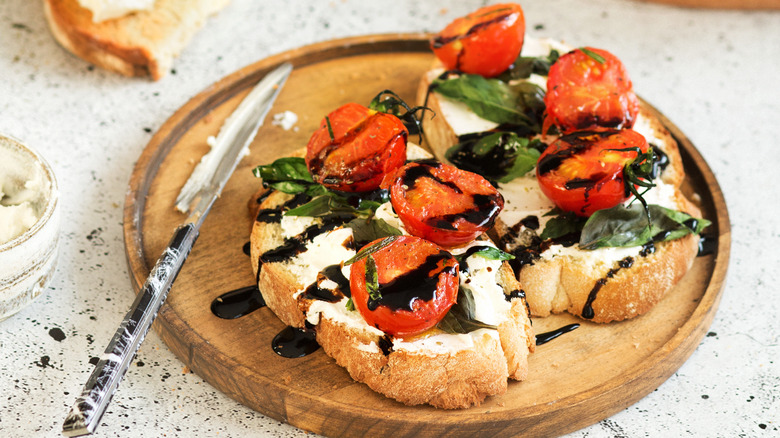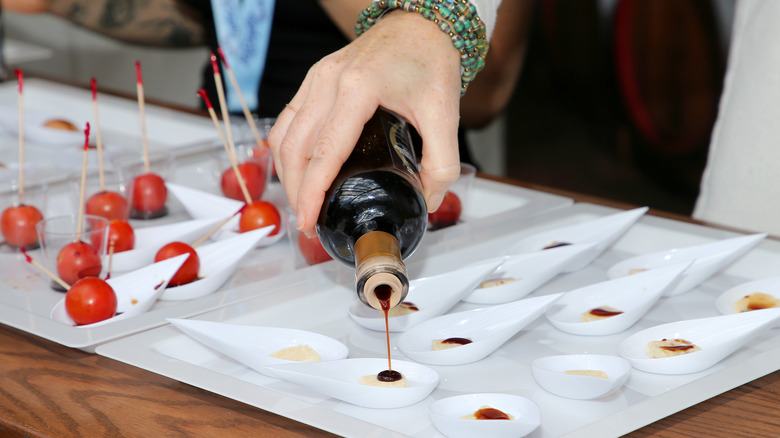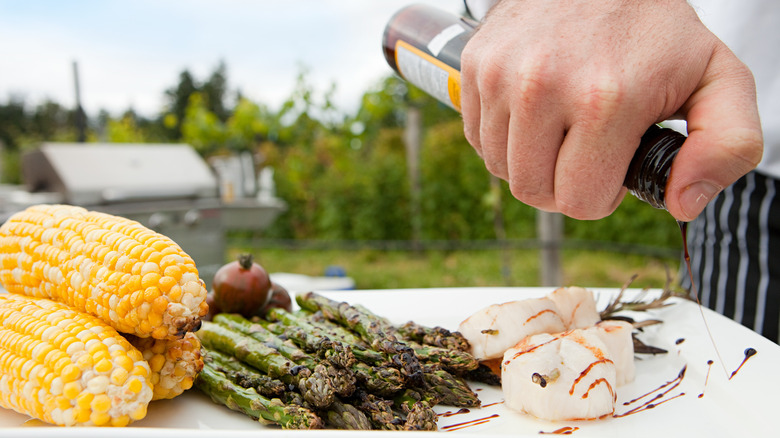Skip The Wine And Opt For A Balsamic Vinegar Tasting (Just Like Giada De Laurentiis)
Featuring a wine tasting at a dinner party is a tried-and-true way to elevate a meal and add an element of intrigue, learning, and sharing among the group. While wine is a traditional pairing choice, there's another tasty alternative to introduce to your next gathering.
If you're looking to cut back on alcohol consumption or simply make food the central focus of your charcuterie board, skip the wine and try a balsamic vinegar tasting instead. In a March TikTok video, Giada De Laurentiis demonstrates how.
Balsamic vinegar is known for its delectable balance of syrupy-sweet and subtle, tart flavor. While you likely have a bottle of balsamic vinegar in your kitchen pantry, there's a whole world of nuanced flavors to be explored. The first step to arranging a balsamic tasting is becoming familiar with various balsamic varieties. And one of the key differences is how long the vinegar is aged.
How to choose the right type of balsamic
Balsamic vinegar is made in Reggio Emilia and Modena, Italy from whole-pressed white grapes (also called grape must). The grapes undergo a cooking process and are then aged in wood barrels. As with wine, there's a spectrum of different flavors that develop based on many factors, including the type of wood barrel used, as well as the aging of the vinegar.
The best way to experience these nuanced, complex flavors is to try a variety of balsamic varieties. To make a homemade balsamic tasting, Giada De Laurentiis recommends picking three balsamic options for the table: a young vinegar aged for three years, an older 12-year-aged balsamic, and what she calls a "wild card" (such as a fruit-infused balsamic) as the final option.
@thegiadzy Welcome to your next dinner party hit: an italian balsamic tasting! Find out more about how to have a balsamic tasting at home here: https://giadzy.com/blogs/tips/how-to-have-a-balsamic-tasting-at-home #balsamicvinegar #balsamictasting #balsamicsoda #balsamicglaze #bestbalsamic #italian #italianfood #italy #giada #giadadelaurentiis #giadzy
Once you taste the vinegars side by side, you'll see the differences in the depth of flavor, color, and viscosity. Young balsamic vinegars (those aged for three to five years) are typically thinner, more transparent in color, and more acidic compared to longer-aged balsamic vinegars. The younger varieties are commonly used for vinaigrettes or in recipes for dishes such as marinated asparagus. Balsamic vinegar aged longer in wood barrels (anywhere from five to 150 years) has a concentrated sweetness; characteristically rich flavors of smoky wood, dark fruit, and chocolate; and a syrupy consistency. As the vinegar ages, a portion of the liquid evaporates into the walls of the wood barrels, causing the texture to thicken and flavors to deepen.
Craft your tasting by pairing complementary tastes
When crafting a balsamic tasting, it's important to know which flavors pair well. A general rule of thumb is to offer cheese, fruits, meats, and vegetables that provide complementary flavors to the rich, subtle sweetness of the balsamic vinegars. It also helps to keep tasting portions simple and bite-sized, so as not to overwhelm the taste buds. You can also offer palate cleansers, such as rustic bread and unflavored sparkling waters, between tastings.
The acidity of younger balsamic options pairs perfectly with earthy vegetables, as well as with hearty breads that will soak up the tart, flavorful liquid. Longer-aged balsamic is best drizzled over rich cheeses with high fat content, such as parmesan or Manchego.
For a wild-card option, try a fruit-infused balsamic, such as cherry or fig, and balance the sweetness with a milky burrata. In the summer, play around with white balsamic vinegar for an added brightness and zest atop peaches or strawberries.


